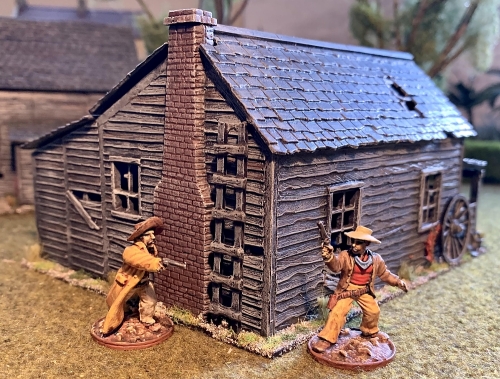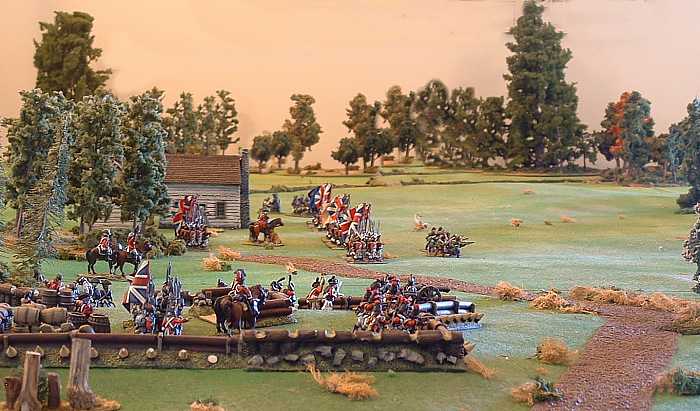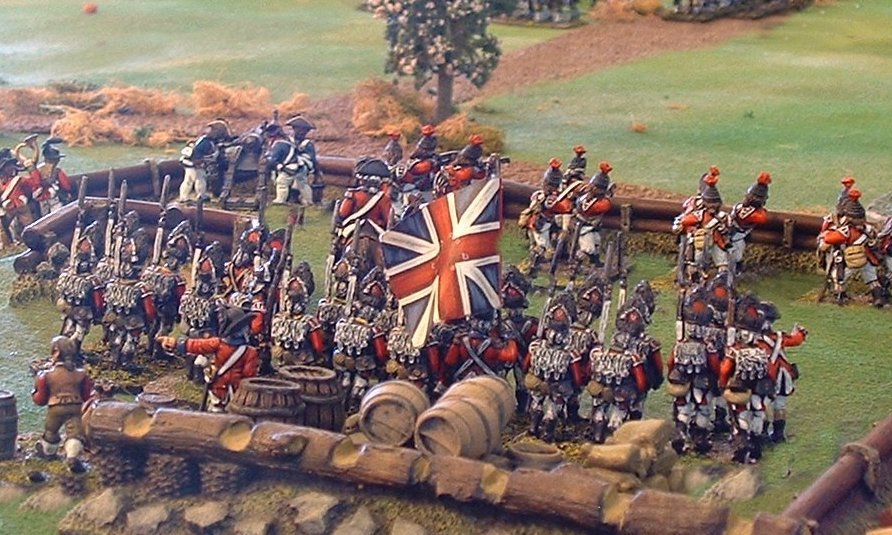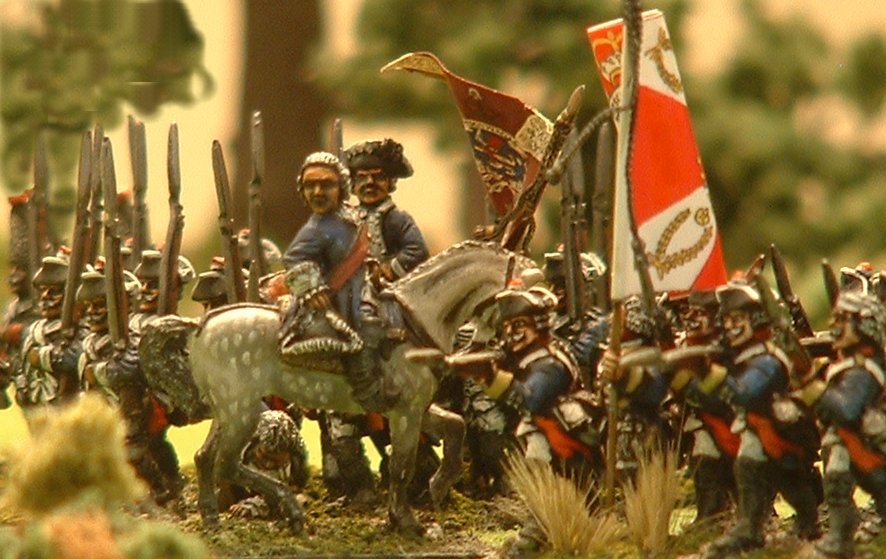
My most memorable American War of Independence wargame took place nearly 20 years ago at the Wellington Warlords’ (the wargaming club of New Zealand’s capital city) annual wargaming competition, ‘Call to Arms’.

At the 2002 event, one of the demo games at ‘Call to Arms’ was a refight of the Battle of Guilford Courthouse, put on by three of the Friday Night Fusiliers – Paul Crouch (3rd from left), Steve Sands (far left) and [a very young-looking!] myself (2nd from left).
A few years after this game, Paul moved to Australia and sold all the wonderful troops in these photos. However, I heard from him recently that he has decided to re-do this project, buying up and painting the troops all over again. He has set up the Sons of Liberty blog to follow his progress.
In talking with Paul, he told me he still has hardcopy photos of the original 2002 game. So I suggested he copy the photos so we could look back at what I think was one of the finest AWI wargames ever, even though it took place nearly nearly two decades ago!

The original Battle of Guilford Courthouse took place on 15 March 1781, between General Cornwallis’s 2,200 British troops and the 4,500 Americans under General Greene.
In the above photo, the British redcoats march out of camp on their way to do battle against the Americans. In the foreground are two cannons and some of their Hessian allies.
The figures and the scenery used in this game all belonged to Paul Crouch. In the main, the figures were by Front Rank, but there were also a few Dixons and Foundry figures.
Paul, Steve and myself were all firm “visual” wargamers, rather than “competitive” or “simulation” players. For us, the main thing was the game had to look good – to be a moving diorama, in effect.

A closeup of the British advance. You can almost hear the drums beating and the fifes trilling The British Grenadier! Behind the redcoats is a battalion of Loyalists, wearing green coats and white trimmed hats.
The British flags were by GMB, who made the best flags around. Paul made the Loyalist flags himself. Note how the flags are realistically shaped – too often the effect of such beautiful flags is spoiled by having them standing out straight like boards.

On the left flank of the British advance are some British light troops, some German Jägers, and even a few Indians.
Paul’s bases were beautifully done – each base was like a mini-diorama. And his figure painting was absolutely exquisite. He used a black undercoat technique and acrylic paints.

The British advance steadily across the clearing towards the first fence-line, where a line of Americans can be see waiting. Behind them, way off in the distance, are more troops in front of the Guilford Courthouse.
The base cloth we used really set off the figures well. It was green baize, but had been sprayed with a mixture of colours. Under the baize was an old carpet which had been laid over some pieces of wood, giving the effect of slightly undulating ground.
You can also see this same photo at the top of this posting, but retouched to make it look a little more real.

Nervous American militia await the redcoats behind a typical switchback railing fence.
These are not the steadiest of troops. But if they can get off a good volley or two before they run, they might slow the steady British advance.
Steve Sands was busy for several nights producing much of the fencing used in our battle.
One of the features that really made this game was the fact that all our battalions were big (at a time when 12-figure units were the popular standard). Each unit had at least six bases of around three or four figures each. Anything smaller does not look anywhere near as good.

The British have forced back the militia through a line of trees. The militia stop, rally bravely, and try to hold the next fence-line. A British and Hessian volley rips through the air.
In the foregound is the last line of American defence. But these troops are no mere militia. These are the regular American infantry, the Continentals. They’re made of sterner stuff, and the British might be worn down by the sniping of the militia before they get to Continentals’ line.

A close-up of the British and Hessian volley. We were using a very simple set of rules called Gentleman Johnny’s War, which made calculating the effect of volleys such as this very easy.
You can never have enough trees in a demo game, especially one set in America. Paul had a huge amount of Woodland Scenics trees, which really looked good on the table.
For the sake of the simplicity, it was decided that trees only interrupted visibility, but didn’t hinder troop movements.

One of the British units charges towards the militia.
By sheer coincidence all the figures in this photo are posed perfectly, as if this was a set-up shot. The charging infantry are in a running pose, while those firing are pointing their muskets. Behind the fence, the militia take pot-shots.

No, the militia can’t stand yet another British volley, so they turn tail and they’re off. But, just as in the movie The Patriot, have they done enough to whittle down the British before they come to grips with the waiting Continentals in the foreground?

Our first sight of the magnificent Architectural Heritage model of the Guilford Courthouse itself. This is a miniature of the actual building. If you look very carefully, you’ll even see the judge standing in the doorway, no doubt encouraging the steady Continentals lined against the fences.
Paul always liked to dot his games with little bits of scenery such as the haystacks you can see in the picture. These were for visual appearance only, and didn’t effect play at all. They were simply moved out of the way when troops passed through.

From behind the Continental lines, you can see the last few militia, and way off in the distance a Hessian flag denotes the British advance.
During March in America, there wouldn’t really have been autumn (‘fall’) trees! But the occasional touch of autumn colours in the trees just gave a lift to the table appearance.
The white house in the far background was hand-made by Paul.

The judge looks on as the battle rages between the British and the Continentals. In the end, the British manage to puncture the Continental centre and creep round their left, so the Americans have to yield the field, just as happened in real life.
Note the barricade of barrels in the foreground – another nice scenic touch.

You would think that General Cornwallis must be feeling pretty pleased with himself. However, in real life the battle cost him 532 casualties against the Americans’ 260.
So instead of pursuing his defeated enemy, he retired to the coast. If this game had been part of a campaign, the result might have been pretty much the same.
There is more fun with scenics in the background – an ammunition dump and wagons to bring powder and balls up to the guns.

One of the most asked-about units in the game, but one which never really came into play, was Tarleton’s Legion. This was because the main protagonist in The Patriot was apparently modelled on Tarleton (though one cannot say that the film representation was at all accurate!).
In the real battle the cavalry did get to grips, but in the game the day was won before they even got onto the scene.

So, just as in real-life, a marginal British win. But more importantly for the Friday Night Fusiliers, a win for presenting the sheer beauty of hundreds of exquisitely painted figures marching and fighting across a gorgeously terrained board!
A special thanks to Wayne Stack, a fellow Fusilier, who took all these wonderful photos as part of an assignment for a police photographer’s course he was on at the time! He was enthusiastic when I told him that Paul still had his photos, and readily gave us permission to publish them here.
I hope you have enjoyed looking back at this spectacular game, and that you’ll follow Paul’s progress on his blog as he recreates his exquisite armies.






































































